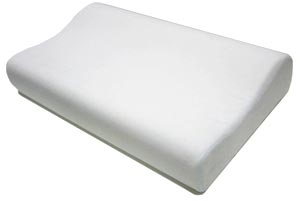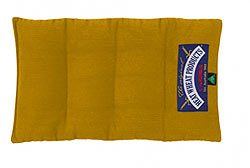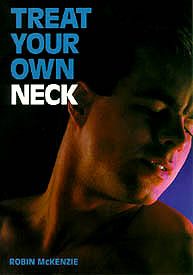Headache (Cervicogenic)
Updated:
(Also known as Headache, Cervical Headache, Neck Related Headache, Referred Pain from the Neck)
What is a cervicogenic headache?
A cervicogenic headache is simply another name for a headache which originates from the neck and is one of the most common types of headache. It is important to note, however, that there are many types of headache of which cervicogenic is just one. Another common type is vascular (this includes migraines).
The spine (neck) comprises of many bones known as vertebrae. Each vertebra connects with the vertebra above and below via two types of joints: the facet joints on either side of the spine and the disc centrally (figure 1).
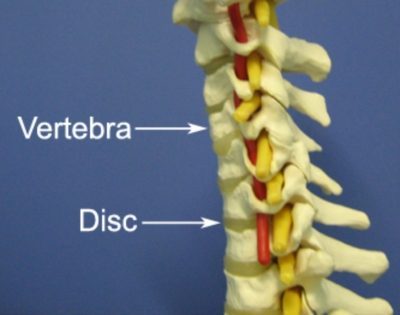
During certain neck movements or sustained postures, stretching or compression force is placed on the joints, muscles, ligaments and nerves of the neck. This may cause damage to these structures if the forces are beyond what the tissues can withstand and can occur traumatically due to a specific incident or gradually over time. When this occurs pain may be referred to the head causing a headache. This condition is known as cervicogenic headache.
Cervicogenic headache typically occurs due to damage to one or more joints, muscles, ligaments or nerves of the top 3 vertebra of the neck. The pain associated with this condition is an example of referred pain (i.e. pain arising from a distant source – in this case the neck). This occurs because the nerves that supply the upper neck also supply the skin overlying the head, forehead, jaw line, back of the eyes and ears. As a result, pain arising from structures of the upper neck may refer pain to any of these regions causing a cervicogenic headache.
Although cervicogenic headache can occur at any age, it is commonly seen in patients between the ages of 20 and 60.
Causes of cervicogenic headache
Cervicogenic headache typically occurs due to activities placing excessive stress on the upper joints of the neck. This may occur traumatically due to a specific incident (e.g. whiplash or heavy lifting) or more commonly, due to repetitive or prolonged activities such as prolonged slouching, poor posture (figure 2), lifting or carrying (especially in poor posture), excessive bending or twisting of the neck, working at a computer or activities using the arms in front of the body (e.g. housework).
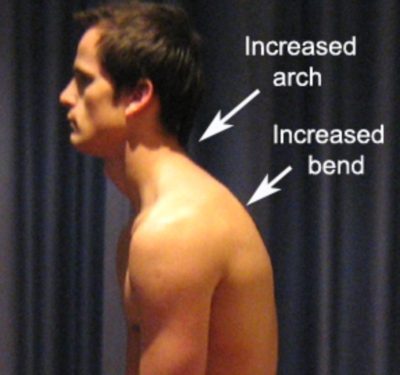
Signs and symptoms of cervicogenic headache
Patients with this condition usually experience a gradual onset of neck pain and headache during the causative activity. However, it is also common for patients to experience pain and stiffness after the provocative activity, particularly upon waking the next morning.
Cervicogenic headache usually presents as a constant dull ache, normally situated at the back of the head, although sometimes behind the eyes or temple region, and less commonly, on top of the head, forehead or ear region. Pain is usually felt on one side, but occasionally, both sides of the head and face may be affected.
Patients with this condition often experience neck pain, stiffness and difficulty turning their neck, in association with their head symptoms. Pain, pins and needles or numbness may also be felt in the upper back, shoulders, arms or hands, although this is less common. Occasionally patients may experience other symptoms, including: light-headedness, dizziness, nausea, tinnitus, decreased concentration, an inability to function normally, and depression.
Patients with cervicogenic headache typically experience an increase in symptoms during certain movements of the neck or sustained positions (e.g. driving or sitting at a computer in poor posture). Patients may also experience tenderness on firm palpation of the upper part of the neck just below the base of the skull along with muscle tightness in this region.
Diagnosis of cervicogenic headache
A thorough subjective and objective examination from a physiotherapist is usually sufficient to diagnose cervicogenic headache. Occasionally, investigations such as an X-ray, MRI or CT scan may be required to assist diagnosis.
Prognosis for cervicogenic headache
Most patients with this condition heal quickly and have a full recovery with appropriate physiotherapy treatment. Recovery time varies from patient to patient depending on compliance with treatment and severity of injury. With ideal treatment, patients with minor cases of cervicogenic headache may be pain free in as little as a couple of days, although sometimes it may take 2 – 3 weeks. In severe or chronic cases a full recovery may take weeks to months.
Contributing factors to the development of cervicogenic headache
There are several factors which can predispose patients to developing cervicogenic headache. These need to be assessed and corrected where possible with direction from a physiotherapist. Some of these factors include:
- poor posture
- neck and upper back stiffness
- muscle imbalances
- muscle weakness
- muscle tightness
- previous neck trauma (e.g. whiplash)
- inappropriate desk setup
- inappropriate pillow or sleeping postures
- a sedentary lifestyle
- a lifestyle comprising excessive slouching, bending forwards or shoulders forwards activities.
- stress
- dehydration
Treatment for cervicogenic headache

Members Only ContentBecome a PhysioAdvisor Member to gain full access to this exclusive content. For more details see Become a Member. Already a member? Login Now
Physiotherapy for cervicogenic headache
Physiotherapy treatment for patients with this condition is vital to hasten the healing process, ensure an optimal outcome and decrease the likelihood of injury recurrence. Treatment may comprise:
- joint mobilization
- joint manipulation
- traction
- soft tissue massage
- dry needling
- electrotherapy (e.g. ultrasound)
- postural taping
- postural bracing
- the use of a lumbar roll for sitting
- education
- anti-inflammatory advice
- activity modification advice
- the use of an appropriate pillow for sleeping
- ergonomic advice
- exercises to improve flexibility, strength (particularly the deep cervical flexors) and posture
- clinical Pilates
Other intervention for cervicogenic headache
Despite appropriate physiotherapy management, a small percentage of patients with this condition fail to improve and may require other intervention. This may include pharmaceutical intervention, corticosteroid injection, investigations such as an X-ray, CT scan or MRI, or referral to appropriate medical authorities who can advise on any intervention that may be appropriate to improve the condition.
Exercises for cervicogenic headache
The following exercises are commonly prescribed to patients with this condition. You should discuss the suitability of these exercises with your physiotherapist prior to beginning them. Generally, they should be performed 2 – 5 times daily and only provided they do not cause or increase symptoms.
Your physiotherapist can advise when it is appropriate to begin the initial exercises and eventually progress to the intermediate and advanced exercises. As a general rule, addition of exercises or progression to more advanced exercises should take place provided there is no increase in symptoms.
Initial Exercises
Chin Tucks
Begin this exercise by sitting or standing tall with your back and neck straight, shoulders should be back slightly. Tuck your chin in as far as you can go without pain and provided you feel no more than a mild to moderate stretch (figure 4). Keep your eyes and nose facing forwards during the movement. Hold for 2 seconds and repeat 10 times provided there is no increase in symptoms. Repeat 3 – 5 times daily. (N.B In some cases it may be beneficial to perform this exercise every 1 or 2 hours provided the exercise does not cause or increase symptoms).
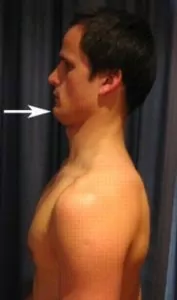
Shoulder Blade Squeezes
Begin this exercise by sitting or standing tall with your back straight. Squeeze your shoulder blades together as hard and far as possible pain-free (figure 5). Hold for 5 seconds and repeat 10 times provided there is no increase in symptoms. Repeat 3 – 5 times daily. (N.B In some cases it may be beneficial to perform this exercise every 1 or 2 hours provided the exercise does not cause or increase symptoms).
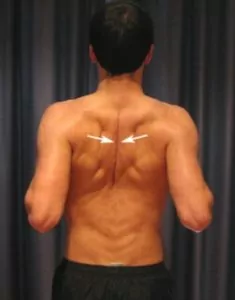
Intermediate Exercises

Members Only ContentBecome a PhysioAdvisor Member to gain full access to this exclusive content. For more details see Become a Member. Already a member? Login Now
Advanced Exercises

Members Only ContentBecome a PhysioAdvisor Member to gain full access to this exclusive content. For more details see Become a Member. Already a member? Login Now
Rehabilitation Protocol

Members Only ContentBecome a PhysioAdvisor Member to gain full access to this exclusive content. For more details see Become a Member. Already a member? Login Now
 Find a Physio
Find a Physio
Find a physiotherapist in your local area who can treat this condition.
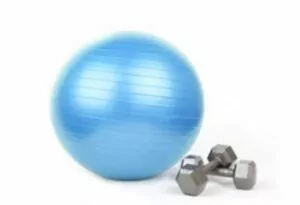 Physiotherapy products for cervicogenic headache
Physiotherapy products for cervicogenic headache
Some of the most commonly recommended products by physiotherapists to hasten healing and speed recovery in patients with this condition include:
To purchase physiotherapy products for cervicogenic headache, click on one of the above links or visit the PhysioAdvisor Shop.
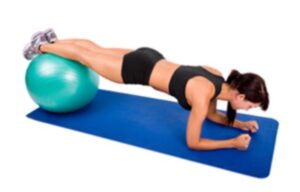 Other Exercises
Other Exercises
- View more Neck Flexibility Exercises.
- View Postural Exercises.
- View Beginner Pilates Exercises to improve core stability and posture.
 More Information
More Information
- View detailed information on Postural Taping.
- View detailed information on improving your Ergonomic Computer Setup.
- View detailed information on when to use Ice or Heat.
- View detailed information on initial injury management and the R.I.C.E. Regime.
- Read about improving your Posture.
- Read our Neck Diagnosis Guide.
Become a PhysioAdvisor Member
-
 Individual Membership (12 Months)$59.95 for 1 year
Individual Membership (12 Months)$59.95 for 1 year -
 Individual Membership (3 Months)$39.95 for 3 months
Individual Membership (3 Months)$39.95 for 3 months -
 Individual Membership (Yearly)$49.95 / year
Individual Membership (Yearly)$49.95 / year -
 Individual Membership (Monthly)$15.95 / month
Individual Membership (Monthly)$15.95 / month

Link to this Page
If you would like to link to this article on your website, simply copy the code below and add it to your page:
<a href="https://physioadvisor.com.au/injuries/neck-head/headache-cervicogenic”>Headache (Cervicogenic) – PhysioAdvisor.com</a><br/>Cervicogenic Headache – Explore causes, signs and symptoms, diagnosis, treatment, exercises, rehabilitation protocol, physiotherapy products and more.
Return to the top of Headache (Cervicogenic).




